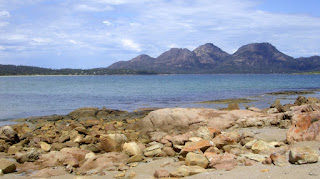The name Tasmania evokes a sense of remoteness and the crossing of rough, southern seas. In the 1820’s—as Van Diemen’s Land--it was a dreaded destination for convicts who were repeat offenders, and whom the authorities really wanted to punish. The Port Arthur and Macquarie prison settlements had shocking reputations as places where brutal floggings were dished out daily. Convicts sent here must have felt that they had reached the end of the world. In the middle of the 19th century, the reputation attached to the name Van Diemen’s Land stank so badly, the residents decided to change the name to Tasmania.
Today Tasmania attracts tourists; but probably because it is accessible only by ferry or air, nowhere seemed overrun with the hordes that we saw in Sydney and Melbourne. The coastal and mountain scenery here is very spectacular.
One popular destination is Freycinet National Park, on the eastern coast, known for its picture-perfect Wineglass Bay, a destination much hyped by travel magazines that tend to omit the fact that it is only accessible by a hike of about an hour over a very steep path. We spent three nights in Coles Bay, close to the entrance to the National Park. The Freycinet Peninsula of rugged pink granite mountains is about 23 miles long and it shelters the bay from the rough seas that batter its eastern, seaward side.
On a wonderfully sunny day, we did the tough climb to the Wineglass Lookout and down to the Bay itself, which was practically deserted.
We completed a circuit to bring us back to the starting point—a tough hike, lots of climbing and rough terrain. It took us 5 hours and 40 minutes, with a few stops to catch our breath.
The next day, we set off to walk on the so-called Friendly Beaches, which proved anything but friendly. The lady at the Visitor Centre had promised us long walks—5 to 10 kms: but she omitted to mention that the walks were more or less impossible when the tide was high. We found the seas pounding the beaches and the rocky outcroppings, with clouds and fog swirling around, and the atmosphere dark, gloomy, and mysterious. Some progress was possible along the beach, but after we had rounded a couple of rocky promontories, we worried the tide might make a return trip impossible.
The nearby town of Bicheno (we’re not sure how to pronounce it), which proclaims that it is “The Tidiest Town in Tasmania,” has a friendly atmosphere and a pleasant foreshore walk, along which is the Blowhole, where the waves come roaring in under the rocks and spew out and up through the hole.
We ended the east coast portion of our stay in Tasmania with some relaxation time at our resort, with its scenic setting on the shore of Coles Bay. Joan had a swim, we did some laundry, and drafted a bit of blogging.
Footnote:















No comments:
Post a Comment